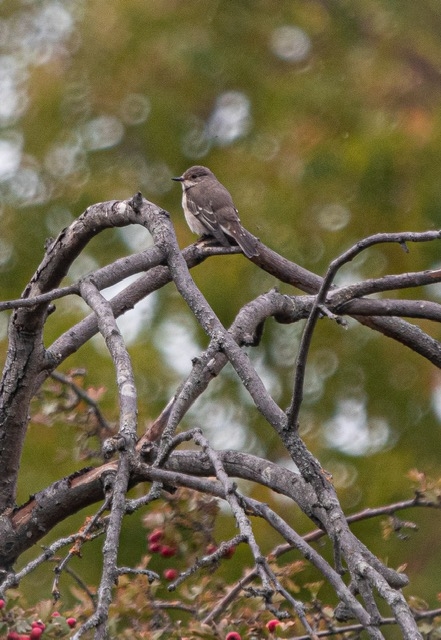
Spotted flycatcher
Photo Credit: @EugeneDH_Bass
Image by Lora Todorova

Spotted flycatcher
Photo Credit: @EugeneDH_Bass
Two barnacle geese, along with the hybrid greylag, returned to the Wetlands on the 6th after their summer break and were seen intermittently throughout the month. Shoveler numbers built to a peak of 75 on the 26th. The first wigeon of the autumn arrived on the 2nd, over a week later than last year. Single birds or pairs were seen on several dates with three seen on the 30th. Much earlier were two goldeneye on Lockwood by MM on the 28th which is a month before their usual return date. They departed as soon as they were seen and were probably day-tripping from KGV which traditionally has the earliest returning goldeneye in London.

Four, Shoveler
Photo Credit: @giles_greenwood
It was a better month for birds of prey. Hobbies were seen regularly right until the end of the month with records from at least six days compared to just one last year. Single buzzards were seen on the 14th and 15th with two on the 5th and red kites on the 2nd and 3rd. There was only one record of each last year. But the star bird of the month was a honey buzzard that SH found going north over Lockwood on the 16th. It is the first definite record of the species since May 2012 although it seems likely that birds seen just further south passed over the reservoirs. Sparrowhawks had a successful breeding season around the Wetlands with three young seen playing together at the north end early in the month.
Common terns hung around much longer than usual. The final bird was last seen on the 14th with five still present on the 8th. In contrast, all the common terns had left last year well before the end of August while the late brood in 2020 departed on the 9th. Even more satisfying for all those involved in building the rafts and colour-ringing the young was news that one of this summer's birds from West Warwick had already been photographed near Cadiz in southern Spain as it made its way south.

Dunlin
Photo Credit: Chris Farthing
Eight species of waders were seen in September, just one below last year’s total but with none of the excitement of 2021’s Little Stints. A single lapwing was seen on the 25th with three on the 30th while the only oystercatcher was on the 2nd. The 2nd also saw the excellent passage of ringed plover continue with three more recorded with another on the 26th while only one dunlin was seen on the 6th.
August’s strong passage of common sandpipers also continued with 18 seen on the 5th, eleven on the 12th and still two on the 29th. Last year, none were seen – until the wintering bird turned up in November – after the 13th with a peak count of only four. Single green sandpipers were seen on the 4th and 29th with the sole redshank on the last day of the month. Snipe were seen feeding out on the reservoir banks on at least two days in September.

Redshank
Photo Credit: Chris Farthing
The second barn owl of the year was seen - just like the first - at the north end of Lockwood on the 20th, having presumably wandered down from further up the valley where they breed. It continued to be a worrying autumn for swifts with very low numbers at the Wetlands. The last bird was seen on the 9th, two days later than in 2021. But the only other record was three on the 4th when 35 were counted last year and 40 in 2019. Unlike last year when no swallows were recorded in September, small numbers were seen with a peak of 12 on the 16th and the last on the 26th. A few sand martins were also seen while 30 house martins were recorded on the 30th.

Willow warbler
Photo Credit: @giles_greenwood
August’s exceptional strong passage of willow warbler continued into early September with seven on the 4th, four still on the 15th and the last on the 25th, six days later than in 2021. An indication of how many chiffchaffs pass through in September are the 39 caught around the No 1 reed bed on the 24th. The final sedge warbler was seen on the same day (18th last year), reed warbler on the 21st – the same date as 2021 - lesser whitethroat on the 24th (21st) and common whitethroat on the 20th (13th).

Stonechat
Photo Credit: @rudraksh9
A redwing was seen on the early date of the 26th, a week before last year’s first but just a day earlier than in 2020. Spotted flycatchers were recorded on the 3rd, 4th, and 5th with three on the 6th and the last on the 24th. The only pied flycatcher – always the rarer of the two at the Wetlands – was on the 5th. A whinchat was on East Warwick from the 2nd to the 6th with others on the 11th, 14th, 18th with the last on the 26th. The first stonechat of the autumn arrived on the 15th – five days earlier than last year but a day later than in 2020 – with perhaps as many as eight on the 26th.

Wheatear
Photo Credit: @Elliott81758817
Wheatears were seen most days in September with a peak count of six on the 14th – just below the highest total of seven last year. But with no records in October so far, it may be that the bird on the 28th will be the last bird of the year. Single yellow wagtails were recorded on at least four days mid-month with two seen on the 28th. Meadow pipits arrived on the 11th – a day earlier than last year - with 16 feeding around Lockwood.

Meadow pipit's
Photo Credit: @AMP
DB @porthkillier